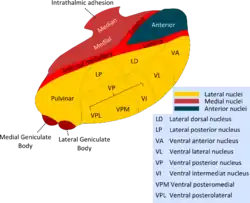Ventral posteromedial nucleus
The ventral posteromedial nucleus (VPM) is a nucleus of the thalamus and serves an analogous somatosensory relay role for the ascending trigeminothalamic tracts as its lateral neighbour the ventral posterolateral nucleus serves for dorsal column–medial lemniscus pathway 2nd-order neurons.[1]
| Ventral posteromedial nucleus | |
|---|---|
 Thalamic nuclei: MNG = Midline nuclear group AN = Anterior nuclear group MD = Medial dorsal nucleus VNG = Ventral nuclear group VA = Ventral anterior nucleus VL = Ventral lateral nucleus VPL = Ventral posterolateral nucleus VPM = Ventral posteromedial nucleus LNG = Lateral nuclear group PUL = Pulvinar MTh = Metathalamus LG = Lateral geniculate nucleus MG = Medial geniculate nucleus | |
 Thalamic nuclei | |
| Details | |
| Identifiers | |
| Latin | nucleus ventralis posteromedialis thalami |
| NeuroNames | 347 |
| NeuroLex ID | birnlex_743 |
| TA98 | A14.1.08.642 |
| TA2 | 5693 |
| FMA | 62202 |
| Anatomical terms of neuroanatomy | |
Inputs and outputs
The VPM contains synapses between second and third order neurons from the anterior (ventral) trigeminothalamic tract and posterior (dorsal) trigeminothalamic tract. These neurons convey sensory information from the face and oral cavity. Third order neurons in the trigeminothalamic systems project to the postcentral gyrus.
The VPM also receives taste afferent information from the solitary tract and projects to the cortical gustatory area.
Subareas
VPMpc
The parvicellular part of the ventroposterior medial nucleus (VPMpc) is argued by some as not an actually part of the VPM, because it does not project to the somatosensory cortex as the remainder of the VPM does, and therefore should be called the ventromedial nucleus (VMb) instead. [2]
Sources
- Kiernan, J., & Rajakumar, R. (2013). Barr's the human nervous system: an anatomical viewpoint. Lippincott Williams & Wilkins.
References
- Sheridan, Nicholas; Tadi, Prasanna (2023), "Neuroanatomy, Thalamic Nuclei", StatPearls, Treasure Island (FL): StatPearls Publishing, PMID 31751098, retrieved 2023-09-17
- Craig, A.D. (2002). "How do you feel? Interoception: the sense of the physiological condition of the body". Nature Reviews Neuroscience. 3 (8): 655–666. doi:10.1038/nrn894. PMID 12154366. S2CID 17829407.
Additional images
 Thalamus
Thalamus